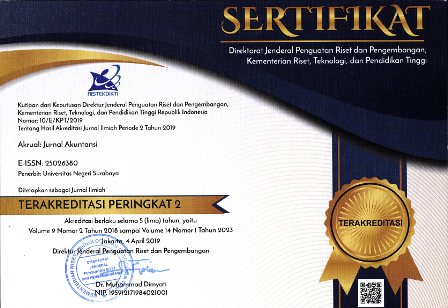Analysis Of Green Accounting To Support Corporate Social Responsibility (Case Study : Semen Gresik Hospital)
DOI:
https://doi.org/10.26740/jaj.v8n1.p1-10Keywords:
Environmental, Green Accounting, HospitalAbstract
Abstract
The Implementation of green accounting in hospital activities is the first step to solved environmental problems. Implementation of green accounting will work up the ability to minimize the environmental problem. The purpose of this accounting process is to improve the efficiency of environmental management by assessing environmental activities from a cost point of view (environmental cost). This research is a descriptive qualitative study using case studies method on Semen Gresik Hospital. This study aims to determine how to conduct environmental management and the application of the concept of green accounting. The research results revealed that Semen Gresik Hospital has not implemented the concept of green accounting yet. This can be seen in the identification of costs, there is no aspect of measurement and clear classification how a costs is categorized as environmental costs or not. The results also showed that the Semen Gresik Hospital had not made the environmental financial report.
References
Arikunto, S. (2010). Prosedur Penelitian Suatu pendekatan praktik. Jakarta: PT. Rineka Cipta.
Belkaoui, A. R.., & Picur, R,D. (1991). Cultural determinism and the perception of accounting concepts. The International Journal of Accounting. 26:118-130.
Bogdan., & Taylor. (1975) dalam J. Moleong, Lexy. 1989. Metodologi Penelitian Kualitatif. Bandung: Remadja Karya.
Carroll, A. (1991). The Pyramid of Corporate Social Responsibility: Toward The Moral Management of Organizational Stakeholders. Business Horizons. DOI: https://doi.org/10.1016/0007-6813(91)90005-g
Deegan, C. (2003). Environmental Management Accounting: An Introduction and Case Studies for Australian, Environment Australia, Environment protection authority: Victoria, Institute of Chartered Accountants Australia. Terdapat pada: nla.gov.au
Drucker, P, F. (1984). Management Task. Responsibility. Practices Harper & Row Publishing Company. New York.
Elkington, J. (1997). Cannibals with Forks. The Tripple Bottom Line of Twentieth Century Business. Harvard Business Review. Boston. DOI: https://doi.org/10.1002/tqem.3310080106
Ginsberg, J,M., & Paul, N, B.(2004). Choosing the Right Green Marketing Strategy. MIT Sloan Management Review. Fall. Volume 4. No 01.
GRI. (2013). Sustainability Reporting Guidelines. www.globalreporting.org. diakses tanggal 16 Juni 2014
Idris. (2012). Akuntansi Lingkungan Sebagai Instrumen Pengungkapan Tanggung Jawab Perusahaan Terhadap Lingkungan di Era Green Market. Jurnal Economac, (online). Vol.2, No.2. http://manajemen.unnes.ac.id.
Irfan, A. (2008). Akuntansi Lingkungan dan Pengungkapannya. Jakarta: Salemba Empat.
Kementrian Kesehatan Republik Indonesia, œData Rumah Sakit Online, 2014. http://www.depkes.go.id (diakses tanggal 1 April 2016)
Lako, A. (2014). Green Economy, Menghijaukan Ekonomi, Bisnis, dan Akuntansi. Jakarta: Erlangga.
Lindrianasari. (2007). Hubungan antara Kinerja Lingkungan dan Kualitas Pengungkapan Lingkungan dengan Kinerja Ekonomi Perusahaan di Indonesia. JAAI. Vol 11. No2. Terdapat pada: journal.uii.ac.id
Moleong, L.J. (2007).Metodologi Penelitian Kualitatif. Bandung: Penerbit PT Remaja Rosdakarya Offset.
Suartana, I W. (2010). Akuntansi Lingkungan dan Tripple Bottom Line accounting: Paradigma Baru Akuntansi Bernilai Tambah. Jurnal Bumi Lestari. (online). Vol.10, No.1, Februari 2010: 105 - 112. Terdapat pada: https://ojs.unud.ac.id/index.php/blje
Subagyo, P. (2004). Statistik Terapan. Yogyakarta: BPFE.
Tanty, H. (2003). Proses Pengolahan Limbah Rumah Sakit Harapan Kita Jakarta: Laporan Hasil Survei. INASEA 4 no 2. P. 85-93. Terdapat pada: https://journal.unesa.ac.id/index.php/aj
Uno, K., & Peter, B. (2004). Environmental Accounting in Theory and Practice. Kluwer Publisher. DOI: https://doi.org/10.1007/978-94-017-1433-4
Wiedmann, T., & Manfred, L. (2006). Third Annual International Sustainable Development Conference Sustainability-Creating the Culture. 15-16 November 2006, Perth, Scotland.
Yakhou, M., & Vernon P, D. (2004). Environmental Accounting:An Essential Component of Business Strategy. Bus. Strat. Env., (online). Vol.13. 2004: 65-77. DOI: https://doi.org/10.1002/bse.395
www.menlh.go.id, (diakses 30 Mei 2016).
Downloads
Published
How to Cite
Issue
Section
 Abstract views: 5757
,
Abstract views: 5757
, PDF Downloads: 2772
PDF Downloads: 2772


















